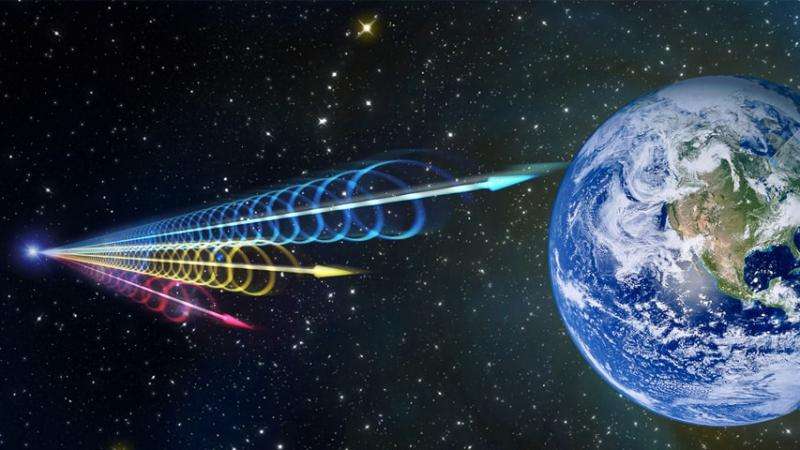December 23, 2015 report
Could fast radio bursts be produced by collisions between neutron stars and asteroids?

(Phys.org)—Fast radio bursts (FRBs) are short bursts of radio emissions from the sky lasting only few milliseconds. However, their origin is still unknown, perplexing astronomers for years since the discovery of the first FRB in 2007. According to various studies, these peculiar radio bursts could be a product of a supernova, two black holes colliding, a spinning neutron star, or they could be related to hyperflares of magnetars. Now, astronomers from the Nanjing University in China are offering another explanation for this puzzling question, asking if collisions of asteroids with neutron stars are producing FRBs.
A paper, detailing the latest finding, co-authored by Yong Feng Huang and Jin-Jun Geng, was published online in the arXiv journal on Dec. 21.
The authors of the paper, using the data from about ten FRBs, obtained key parameters that could help solve the mystery of these radio bursts. FRBs were generally discovered through single-pulse search methods by using archive data of wide-field pulsar surveys at the multi-beam 64-meter Parkes radio telescope in Australia and the 305-meter Arecibo telescope, located in Puerto Rico.
FRBs are usually detected by large radio telescopes at 1.4 GHz. These events are of extremely short duration, typically lasting for less than a few milliseconds, but are detected with high intensity. The researchers noted that there are four main stages of detecting fast radio bursts.
"First, the radio telescopes are uniformly pointing toward the sky at the time of the detections. Second, for the multi-beam receiver system, usually the signal was recorded only in very few beams, typically less than four, especially by adjacent beams. Third, FRBs are characterized by large dispersion measure (DM) values, significantly larger than terrestrial sources of interference. Fourth, the observed behaviors of time delay and frequency evolution of FRBs strongly indicate that cold-plasma dispersion should have been engraved in the radio signal," the scientists wrote in the paper.
The astronomers noted also that FRBs cannot be quickly followed up to catch the counterparts in other wavelengths, as they are generally screened out from archive data, as was done by Huang and Geng in their latest research. Thus, the absence of counterparts poses great difficulties in understanding the true nature of FRBs.
The authors of the paper insist that the explanations offered by previous studies are unsatisfactory when it comes to the origin of these radio bursts. They imply that a very strong electromagnetic outburst or multi-band afterglow would be triggered and should be observed tin association with the FRB event. However, non of these phenomena have been observed.
The new hypothesis, presented in the study, can account for many of the observational characteristics of FRBs, such as the duration, the energetics and the event rate. They suggest that the collision between asteroids and neutron stars can reasonably explain many of the observed features.
Scientists have expected that the collision of small bodies with neutron stars can give birth to some kinds of X-ray bursts or some special gamma-ray bursts. The new research accounts for the possibility that these collisions are behind fast radio bursts.
"Our model can naturally explain the millisecond duration of FRBs. It can also well account for various other aspects of FRBs," the scientists wrote.
They hope that the future Chinese 500-meter Aperture Spherical Radio Telescope (FAST), which is expected to be ready for observations in late 2016, can contribute to the study of the multidimensionality of such collisions and will reveal new insights into the nature of FRBs.
More information: Collision between Neutron Stars and Asteroids as a Mechanism for Fast Radio Bursts, arXiv:1512.06519 [astro-ph.HE] arxiv.org/abs/1512.06519
Abstract
As a new kind of radio transient sources detected at ∼1.4 GHz, fast radio bursts are specially characterized by their short durations and high intensities. Although only ten events are detected so far, fast radio bursts may actually frequently happen at a rate of ∼103 —- 104 sky−1 day−1. We suggest that fast radio bursts can be produced by the collisions between neutron stars and asteroids. This model can naturally explain the millisecond duration of fast radio bursts. The energetics and event rate can also be safely accounted for. Fast radio bursts thus may be one side of the multifaces of the neutron star-small body collision events, which are previously expected to lead to X-ray/gamma-ray bursts or glitch/anti-glitches.
© 2015 Phys.org




















